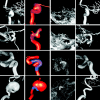Aneurysm rupture following treatment with flow-diverting stents: computational hemodynamics analysis of treatment
- PMID: 21071533
- PMCID: PMC7964947
- DOI: 10.3174/ajnr.A2398
Aneurysm rupture following treatment with flow-diverting stents: computational hemodynamics analysis of treatment
Abstract
Background and purpose: Flow-diverting approaches to intracranial aneurysm treatment had many promising early results, but recent apparently successful treatments have been complicated by later aneurysm hemorrhage. We analyzed 7 cases of aneurysms treated with flow diversion to explore the possible rupture mechanisms.
Materials and methods: CFD analysis of pre- and posttreatment conditions was performed on 3 giant aneurysms that ruptured after treatment and 4 successfully treated aneurysms. Pre- and posttreatment hemodynamics were compared including WSS, relative blood flows, vascular resistances, and pressures, to identify the effects of flow-diverter placements.
Results: Expected reductions in aneurysm velocity and WSS were obtained, indicating effective flow diversion from the sac into the parent artery, consistent with periprocedural observations. In each case with postaneurysm rupture, the result of flow diversion led to an increase in pressure within the aneurysm. This pressure increase is related to larger effective resistance in the parent artery from placement of the devices and, in 2 cases, the reduction of a preaneurysm stenosis.
Conclusions: Flow-diversion devices can cause intra-aneurysmal pressure increases, which can potentially lead to rupture, especially for giant aneurysms. This relates both to changes in the parent artery configuration, such as reduction of a proximal stenosis, and to the flow diversion into higher resistance parent artery pathways combined with cerebral autoregulation, leading to higher pressure gradients. These may be important effects that should be considered when planning interventions. Potentially dangerous cases could be identified with angiography and/or patient-specific CFD models.
Figures





Comment in
-
Regarding "Aneurysm rupture following treatment with flow-diverting stents: computational hemodynamics analysis of treatment".AJNR Am J Neuroradiol. 2011 May;32(5):E95-7; author reply E98-100. doi: 10.3174/ajnr.A2534. Epub 2011 Apr 21. AJNR Am J Neuroradiol. 2011. PMID: 21511857 Free PMC article. No abstract available.
-
Computational modeling and flow diverters: a teaching moment.AJNR Am J Neuroradiol. 2011 Jun-Jul;32(6):981-3. doi: 10.3174/ajnr.A2711. Epub 2011 May 26. AJNR Am J Neuroradiol. 2011. PMID: 21622579 Free PMC article. No abstract available.
References
-
- Lylyk P, Ferrario A, Pasbon B, et al. . Buenos Aires experience with the Neuroform self-expanding stent for the treatment of intracranial aneurysms. J Neurosurg 2005;102:235–41 - PubMed
-
- Lövblad KO, Yilmaz H, Chouiter A, et al. . Intracranial aneurysm stenting: follow-up with MR angiography. J Magn Reson Imaging 2006;24:418–22 - PubMed
-
- Szikora I, Berentei Z, Kulcsar Z, et al. . Endovascular treatment of intracranial aneurysms with parent vessel reconstruction using balloon and self-expandable stents. Acta Neurichir 2006;148:711–23 discussion 723. Epub 2006 May 17 - PubMed
-
- Lylyk P, Miranda C, Ceratto R, et al. . Curative endovascular reconstruction of cerebral aneurysms with the Pipeline embolization device: the Buenos Aires experience. Neurosurgery 2009;64:632–42 - PubMed
Publication types
MeSH terms
LinkOut - more resources
Full Text Sources
Medical
Research Materials
Miscellaneous
